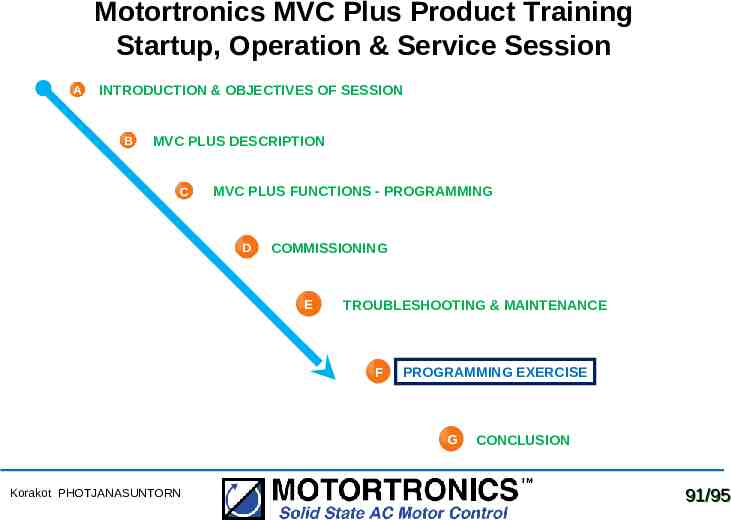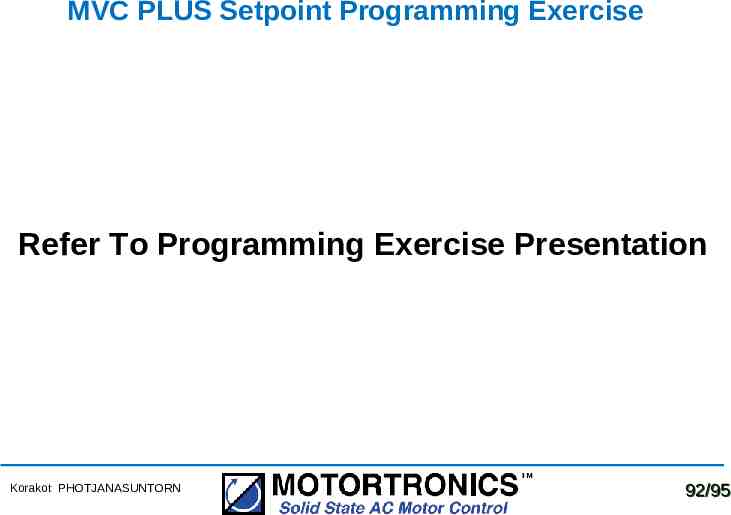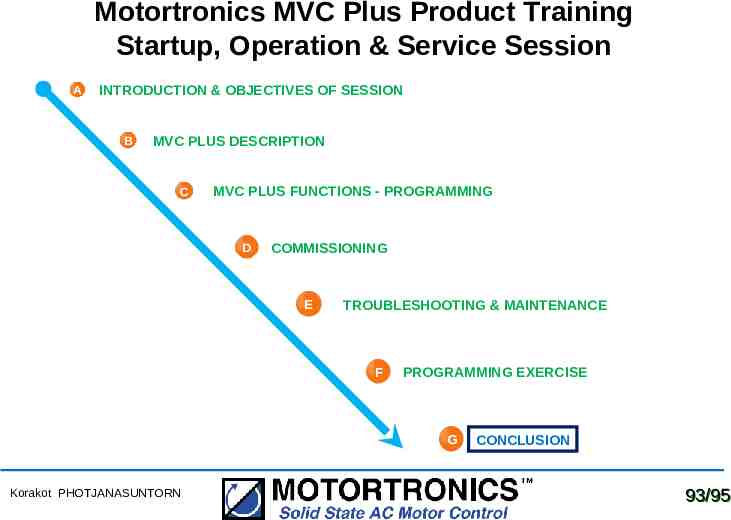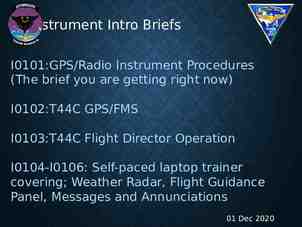Korakot PHOTJANASUNTORN 1/95
95 Slides5.74 MB
Korakot PHOTJANASUNTORN 1/95
Motortronics MVC Plus Product Training Startup, Operation & Service Session A INTRODUCTION & OBJECTIVES OF SESSION B MVC PLUS DESCRIPTION C MVC PLUS FUNCTIONS - PROGRAMMING D COMMISSIONING E TROUBLESHOOTING & MAINTENANCE F PROGRAMMING EXERCISE G Korakot PHOTJANASUNTORN CONCLUSION 2/95
ObjectivesMVC List -Plus A Product Training Motortronics Startup, Operation & Service Session A INTRODUCTION & OBJECTIVES OF SESSION B MVC PLUS DESCRIPTION C MVC PLUS FUNCTIONS - PROGRAMMING D COMMISSIONING E TROUBLESHOOTING & MAINTENANCE F PROGRAMMING EXERCISE G Korakot PHOTJANASUNTORN CONCLUSION 3/95
INTRODUCTION Who Am I, & Who Are You? What Do I Do ? What Services Do You Typically Provide For Your Company (Sales, Field Service, Maintenance)? Have You Already Worked With A Motortronics MVC Plus Soft Starter? What Do You Expect To Gain From This Session? Korakot PHOTJANASUNTORN 4/95
OBJECTIVES FOR THIS COURSE WORK After Completion Of This Training Session, Attendees Should Be Able To: Describe The Functions And Typical Field Applications Of An MVC Plus Medium Voltage Soft Starter Identify Key Components Of The Soft Starter Define Input Connections & Default Settings Successfully Commission An MVC Plus Soft Starter Troubleshoot An MVC Plus Soft Starter Find Needed Information In The Support Documentation Korakot PHOTJANASUNTORN 5/95
ObjectivesMVC List -Plus B Product Training Motortronics Startup, Operation & Service Session A INTRODUCTION & OBJECTIVES OF THIS SESSION B MVC PLUS DESCRIPTION C MVC PLUS FUNCTIONS - PROGRAMMING D COMMISSIONING E TROUBLESHOOTING & MAINTENANCE F PROGRAMMING EXERCISE G Korakot PHOTJANASUNTORN CONCLUSION 6/95
Abbreviations Used In This Presentation CPU DCU FLA FLC GTO HMI HP IGBT Central Processing Unit Digital Control Unit Full Load Amperes Full Load Current Gate Turn Off Human Machine Interface Horse Power Insulated Gate Bipolar Transistor LRA Locked Ramp Amperes MOV Metal Oxide Varistor MVSS Medium Voltage Soft Starter Korakot PHOTJANASUNTORN MVSS Medium Voltage Soft Starter OL Over Load RTD Resistance-Temperature Device RVAT Reduced Voltage Autotransformer SCR Silicon Controlled Rectifier (Thyristor) SF Service Factor RVSS Reduced Voltage Soft Starter TCB Terminal & Control Board 7/95
Soft Starter - Basic Features Main Fuses Medium Voltage R-Style Motor Protection Fuses Isolation Switch (Disconnector) Provides Isolation Of Soft Starter From Power Supply Vacuum Isolation Contactor Provides Start Sequence To SCR Stack Assembly Isolated Low Voltage Control CPT & PT Transformers Supply Control Power And SCR Firing Detection Korakot PHOTJANASUNTORN SCR Stack With I2t Overload Provides Voltage Ramp And Advanced Protection Features Vacuum Bypass Contactor Bypasses SCRS When Motor Reaches Full Speed 8/95
The MVC PLUS - Defined The MVC Plus Incorporates A Complete Reduced Voltage Soft Starter System Within a NEMA 12R Drip-Proof Enclosure. Reduced Voltage Solid-State Devices (SCRs) Vary The Amount Of The AC Sine Wave Sent To The Motor. The MVC Plus Accelerates And Decelerates A Motor By Limiting The Current Through Voltage Phase Angle Control. Once The Motor Is At Full Voltage, The Soft Starting System Is Bypassed With A Contactor. Power Network Medium Voltage Soft Starters Are NOT Variable Speed Drives And Do Not Have The Functionality Of A Drive. They Are NOT Cheap Drives! Main Contactor Korakot PHOTJANASUNTORN Protection Soft Starter Motor Load Bypass Contactor 9/95
Goals Beyond Simple On & Off Starting Protect The Motor And Load Reduce Mechanical Stress Limit Starting Current Reduce Stress On The Electrical Grid Reduce Electrical System Disturbance Provide Soft Stopping Meter & Record Communicate Korakot PHOTJANASUNTORN 10/95
MVC PLUS Metering Features 10 Current Based Metering Functions 6 Status Screens Recorder for 60 Events with Time / Date Stamp 29 RTD Option Screens Voltage Monitoring Functions – Including Line Voltage, Frequency, PF, kW, kW Demand, kVAR, kVAR Demand, kWH, kVA, kVA Demand. Statistical Data Capture With Demand Reset Korakot PHOTJANASUNTORN 11/95
Human / Machine Interface Full Digital Control – LCD Operator Interface – Non-Volatile Memory Digital Sequencer – Ensures Proper Contactor Sequence Fiber-Optic Isolation (Operator Protection) Metering Functions RS-422 Comunication Buss Between COM Board And CPU Board Korakot PHOTJANASUNTORN 12/95
MVC PLUS Medium Voltage Soft Starter Applications Pump Ball Mill Blower Rod Mill Compressor Conveyor Chiller Power Conversion Fans HVAC Chipper Shredder Other Applications Korakot PHOTJANASUNTORN 13/95
Description Of Solid State Devices Input Gate Output Several types of electrical devices can be used to manipulate power These devices are based on semi-conductor principles When used in industry, they are normally referred to as “Power Electronics” Diodes have no gate input to control them. They simply Diode Output SCR Output GTO Output Korakot PHOTJANASUNTORN allow current to flow in one direction and block current flowing from the opposite direction. The net output with an AC input is a ½ sine wave. SCRs (Silicon Controlled Rectifier) have a gate input used to turn them on but then act like a diode. They cannot turn off until the AC current reverses direction in the next ½ alternation of the sine wave. Like a diode, they only work in one direction. Motor soft starters use SCRs almost exclusively. GTO (Gate Turn Off) SCRs, IGBTs (Insulated Gate Bipolar Transistors) and similar devices can be turned on and off to create output waveforms independent of the zero crossing point of the half alternation of the sine wave. These devices work similar to the control valves of a fluid pumping system (On/Off). Like diodes and SCRs, they also only work in one direction. 14/95
Solid State Devices – SCR Function input gate gate Output input Output Waveform Direction To create an electrical device that can function on both halves of the sine wave, two devices are needed, one for each direction. Each gate drive needs to be electrically isolated since they are at completely different potentials in relation to the cathodes of the SCRs. We can turn an SCR on at some point before the current zero crossing point of the sine wave. When the current of the ½ alternation of the sine wave crosses the zero point, the SCR will turn off. In order for the SCR to conduct for the next ½ alternation, the SCR must have a gate signal applied again before the next zero crossing point. SCR Switching Dampened By DV/DT (RC) Network Input R c The SCR output is typically coupled to a DV/DT (RC) network to help reduce voltage switching transients. DV/DT networks are important because they help eliminate false triggering of SCRs. Output Korakot PHOTJANASUNTORN 15/95
SCR Control Assembly Phase A [L1] Input Phase B [L2] Input Phase C [L3] Input Gate Drive Computerized Controller DV/DT DV/DT DV/DT Current / Temp / Voltage Feedback Phase A [T1] Output Phase B [T2] Output Phase C [T3] Output Looking at a whole system as a unit, each phase of the medium voltage power supply connects to its own SCR ‘Stack Assembly’. The Digital Control Unit (DCU) controls the gate drive outputs in order to turn the SCRs on based on detecting the point where the current sine wave crosses the zero horizon. This is a very basic block diagram an SCR control system, but is a good representation of its fundamental operation. Korakot PHOTJANASUNTORN 16/95
Rugged Gate Firing Circuit Auto-Synchronizing To Line Independent Phase Tracking Best Sensing Circuit For Generator Power Measure Measure Measure Measure Measure Measure Fire Korakot PHOTJANASUNTORN Fire Fire Fire Fire Fire 17/95
Rugged Gate Firing Circuit Competition Uses A Cheaper System Measure Once (Bet You Can Guess The Rest!) Susceptible To Frequency Drift, Noise Measure Once “Phase Locked Loop” Firing: 6 Pulses From One Signal Korakot PHOTJANASUNTORN Fire Fire Fire 18/95
Hockey Puck Style SCR Informational Purposes ONLY SCRs Will Not Be Examined At This Level In The Field Anode Cathode Gate Korakot PHOTJANASUNTORN 19/95
Typical MVC PLUS SCR Stack Assembly This SCR stack assembly is the lowest level that may be replaced at customer site. Field service representatives will not be required to replace SCRs within this assembly in the field due to SCR matching requirements, specialty tooling and the specific compressive forces needed to properly clamp the SCRs into an assembly. SCR Korakot PHOTJANASUNTORN 20/95
Soft Starter Medium Voltage Compartment DV/DT Boards The DV/DT Boards are used to reduce voltage transients across the stack assemblies MOV (Metal Oxide Varistor) Boards The primary function of the MOV Boards are to protect the Gate-to-Cathode interface within each individual SCR. Temp/CT Boards Provides SCR temperature and 3-phase current data to the DCU Gate Drive Boards Sends firing control signals to the SCRs DV/DT Boards MOV Boards Temp/CT Board Gate Drive Boards Korakot PHOTJANASUNTORN 21/95
MVC PLUS Electrical Isolation Diagram Magnetic Isolation Gate Drive MTR Korakot PHOTJANASUNTORN MV 120V 28V Fiber Optic Sensing Systems Optical Isolation LV Controls 22/95
Fiber Optics - Description Introducing the Light Source In a fiber optic cable, as light is introduced into the end of the fiber at an angle that is directly in line with its axis, the light is guided through the core to the opposite end. Due to its design, the fiber acts as an optical waveguide, bouncing the 660 nanometer (optical red) light at equal distances off of its walls. Internal Reflection When a ray of light (at the correct wavelength) is introduced into the fiber-optic cable, it bounces down its length, striking the core-to-cladding surface at an angle that will reflect it back into the core. If the angle of reflection is correct, the reflected light continues to be reflected down the length of the fiber with minimal loss. Korakot PHOTJANASUNTORN 23/95
Fiber Optics - Description Construction Korakot PHOTJANASUNTORN 24/95
Fiber Optics - Description Cladding - A Semi-Reflective Material Korakot PHOTJANASUNTORN 25/95
MVC PLUS - Fiber Optics Facts 1000 micron (1 millimeter) diameter core Plastic Optical Fiber (POF) Cladding is a semi-reflective coating on the core 660 nanometer wavelength, optical red light Not a laser, will not damage eyesight 1 megabit maximum transmission rate, actual signal is 250 kHz max Maximum 1 kilometer transmission length, less than 4 meters (per fiber length) in RVSS SCR firing transmitters are 10mm water-clear LEDs (Light Emitting Diodes) mounted on the Main Board Korakot PHOTJANASUNTORN 26/95
MVC PLUS Controller - Additional Features 3 Level Non-Volatile Memory System – High speed RAM for system operation – EPROM for Factory Settings and Defaults – EEPROM for User Settings – No battery backup required for user settings Real Time Clock – Used in protection and metering – 10 year battery backup Korakot PHOTJANASUNTORN 27/95
MVC PLUS Controller - Communications RS485 Modbus RTU Built-In RS232 Windows Based Programming / Monitor Program Korakot PHOTJANASUNTORN 28/95
Motortronics MVC Plus Product Training Startup, Operation & Service Session A INTRODUCTION & OBJECTIVES OF SESSION B MVC PLUS DESCRIPTION C MVC PLUS FUNCTIONS - PROGRAMMING D COMMISSIONING E TROUBLESHOOTING & MAINTENANCE F PROGRAMMING EXERCISE G Korakot PHOTJANASUNTORN CONCLUSION 29/95
MVC PLUS Setpoint Page 1 Where To Input Motor Nameplate Data These Settings Include Data Used By The CPU For Motor Thermal Capacity Modeling Motor FLA And Service Factor Are Governed By (SF x FLA) Calculation For Unit Maximum Current In Setpoint Page 13 (More Information Later) Korakot PHOTJANASUNTORN 30/95
MVC PLUS Setpoint Page 1 Basic Overload Protection - Start Up (& Run) NEMA / UL Pre-Programmed O/L Trip Curves Class 5 Through Class 30 600 100 Seconds Class 30 Class 20 10 100% 400% 600% Class 10 %FLA Korakot PHOTJANASUNTORN 31/95
MVC PLUS Setpoint Page 2 Motor Starting, Deceleration And Ramp Type Settings Most Starting Situations Require Only VOLTAGE RAMP With CURRENT LIMIT Starting Profile The INITIAL VOLTAGE Setting Is Used To Move The Rotor From A Standstill And Nothing More The RAMP TIME Setting Is An Approach Vector Between INITIAL VOLTAGE Setting And CURRENT LIMIT Setting. A Long RAMP TIME Setting Delays The Time For The MVC Plus To Settle Into CURRENT LIMIT Mode The CURRENT LIMIT Setting Is Where The “Real Work” Begins. The Maximum Power (Setpoint Limited) That Is Applied To The Motor When The MVC Plus Is Operating In CURRENT LIMIT. If The Starter Trips On Acceleration Time Trip, Increase CURRENT LIMIT To Reduce The Starting Time Korakot PHOTJANASUNTORN 32/95
Typical Starting Profile Voltage Ramp With Current Limit Initial Voltage - Setpoint 2.3.V1 Ramp Time - Setpoint 2.3.V2 Current Limit - Setpoint 2.3.V3 CURRENT LIMIT VOLTS / AMPS RAMP TIME AT SPEED INITIAL VOLTAGE TIME Korakot PHOTJANASUNTORN 33/95
MVC PLUS Setpoint Page 2 Advanced Ramp Features Ramp Features – Voltage Ramp w/ Current Limit – Current Limit / Current Step – Closed Loop Current / Torque Ramp – Tach. Feedback Speed Ramp Custom Ramp Profiling Dual Ramps Pump Control / Deceleration Korakot PHOTJANASUNTORN 34/95
MVC PLUS Setpoint Page 2 Dual Ramp - Soft Start Start Ramp 1 Selected Ramp 1 - Voltage Ramp w/ Current Limit Current Limit Setting Ram p Full Star Speed Current Level Held to t Ram Current Limit Limit Setting p overrides Ramp Time Time Korakot PHOTJANASUNTORN 35/95
MVC PLUS Setpoint Page 2 Dual Ramp - Near ATL Start Ramp 2 Selected Ramp 2 - Loaded Restart, “Near Across-the-Line” Almost Full-Voltage Start, No Ramp Time High Current Near Full-Torque Starting Korakot PHOTJANASUNTORN 36/95
MVC PLUS Setpoint Page 2 Uses For Dual Ramp Profiles Loaded Restart After a Power outage – Conveyors, Crushers Higher Torque for Occasional Starting Requirements – Specialized Machinery – Design C Motors – Two-Speed Motors (To Start At Either Speed) Korakot PHOTJANASUNTORN 37/95
MVC PLUS Setpoint Page 2 Shorted Load Protection During Start “Toe-in-the-Water” Circuit – First 1/4 second of ramp time – Checks rate of current rise – Prevents collateral damage MOTOR CURRENT Start Trip VOLTS Initial Torque Setting 1/4 Second Korakot PHOTJANASUNTORN 38/95
MVC PLUS Setpoint Page 2 Flexible Deceleration - Pump Control Allows Full Adjustment Independent of Acceleration Ramp Start Ramp Automatic Stop Level - Prevents excessive heating in the motor Run Begin Decel Stop Valve Closes Here Voltage Torque Korakot PHOTJANASUNTORN (Coast) 39/95
Pump Control - Hydraulic System Problems Trapping the kinetic energy of moving water causes “WATER HAMMER” – Check valves keep head pressure from pushing fluids backwards into the pump PUMP OFF ON PUMP PUMP FLOW Korakot PHOTJANASUNTORN VALVE CLOSED HEAD PRESSURE 40/95
Pump Control - Hydraulic System Problems Trapping the kinetic energy of moving water causes “WATER HAMMER” – Check valves keep head pressure from pushing fluids backwards into the pump. PUMP ON PUMP FLOW Korakot PHOTJANASUNTORN VALVE OPENS PRESSURE PUMP PRESSUREHEAD / FLOW 41/95
Pump Control - Hydraulic System Problems PUMP OFF PUMP FLOW Korakot PHOTJANASUNTORN VALVE CLOSES HEAD PRESSURE 42/95
Pump Control - Hydraulic System Problems Trapping the kinetic energy of moving water causes “WATER HAMMER” – When the pump suddenly stops, flow reverses until check valve closes. The energy of the back-flowing water is trapped, creating a SHOCK WAVE traveling at the speed of sound Liquids don’t compress, so energy is forced onto piping, fittings and seals PUMP OFF Korakot PHOTJANASUNTORN VALVE CLOSES 43/95
Pump Control - Hydraulic System Problems Controlled Deceleration can reduce Water Hammer Reduced pump pressure closes valves more slowly, at near-neutral pressure – Kinetic energy is slowly dissipated – Shock wave is not created PUMP OFF PUMPSTOP ON SOFT Korakot PHOTJANASUNTORN VALVE VALVEOPEN CLOSING CLOSED VALVE 44/95
MVC PLUS Setpoint Page 3 Phase and Ground Detection Settings All Trip and Alarm Settings can be enabled / disabled and Values for Trip / Alarm are programmed here * * With the exception of Acceleration Time Trip Setting located in Setpoint Page 8 and RTD / Thermal Capacity Alarm Settings in Setpoint Page 12 Korakot PHOTJANASUNTORN 45/95
MVC PLUS Setpoint Page 3 Electrical Protection Features Over Voltage Under Voltage Frequency Window Phase Current Loss Phase Current Imbalance Shorted Load Protection Zero Sequence Ground Fault Option Korakot PHOTJANASUNTORN 46/95
MVC PLUS Setpoint Page 3 Load Protection Over Current – Jam relay, electronic shear pin Under Current – Load loss, broken belt, loss of prime Phase Sequence – ABC, ACB, or Disabled Anti-Oscillation Control – Prevents surging in pump systems Korakot PHOTJANASUNTORN 47/95
MVC PLUS Setpoint Page 4 Output Relay Assignments. Up to 3 Relays can be assigned per Trip / Alarm function. Dedicated Relays – Aux 1 Trip – Aux 2 Alarm – Aux 3 Run Indication – When current is above 7% of programmed FLA – Aux 4 Bypass Contactor Korakot PHOTJANASUNTORN 48/95
MVC PLUS Setpoint Page 5 Output Relay Configuration. Output Relays can be assigned for failsafe and whether Latched or Not. Aux 1 (Trip) must be Latched. First 4 Relays are pre-assigned from the factory. Relays 5 – 8 can be assigned to Trip / Alarm functions and wired as needed. Korakot PHOTJANASUNTORN 49/95
MVC PLUS Setpoint Page 6 User Input / Output Configuration. 4-20 mA Tachometer Input. 4-20 mA Analog Outputs 1 & 2. 4 Programmable External Input Trip Korakot PHOTJANASUNTORN Channels 50/95
MVC PLUS Setpoint Page 6 Programmable Input / Output Features 120V Inputs – 2 wire or 3 wire control, external trip. 1 Analog Tachometer Input – 4-20mA signal. The pickup for the signal generator to the starter must be at least 4 pulses/rotation from the motor shaft. 4 Programmable External Input Trip Channels – 1, 3 & 4 are for Factory Use Only. This is a 5VDC loop. Use dry contacts only, do not apply AC power to this loop. 8 Digital Outputs – Each can be assigned to alarms and/or trips – Not used in Start/Stop circuit 2ea 4-20ma Analog Outputs – Programmable for RMS Current, % Motor Load, Bearing Temperature, Stator Temperature, or RPM Korakot PHOTJANASUNTORN 51/95
MVC PLUS Setpoint Page 7 Custom Acceleration Curve. 3 Separate Curves - A, B & C. 8 Programmable Steps – Voltage and Duration for each step. Maximum Current Threshold Set point. Korakot PHOTJANASUNTORN 52/95
MVC PLUS Setpoint Page 7 Custom Ramp Profiles 3 Programmable Custom Curves 8 Data Points in Each Enter Voltage, Current, Time – Match ramp profile to practically any application Korakot PHOTJANASUNTORN 53/95
MVC PLUS Setpoint Page 8 3 Overload Protection Choices During Start-up Basic Overload Protection for Start (& Run) – Programmable overload Class 5 – 30 – Measured Start Capacity – I2t thermal capacity from data Learned Curve Protection – Starter learns from recorded data Korakot PHOTJANASUNTORN 54/95
MVC PLUS Setpoint Page 8 Measured Start Capacity For Start Up Uses basic overload curve as programmed User enters maximum I2t value from motor manufacturer or commissioning data Basic curve is altered Matches motor more closely Measured I2t capacity Area Under Curve protection Class 20 I2t curve Korakot PHOTJANASUNTORN 55/95
MVC PLUS Setpoint Page 8 Overload Protection Benefits Provides “Trip Free” Overload (No over-ride) – Cannot be defeated by cycling power – Not all solid state overloads do this! Prevents Motor Damage – Protection from careless operators. Korakot PHOTJANASUNTORN 56/95
MVC PLUS Setpoint Page 8 2 Overload Protection Choices During Run Basic Overload Protection – Run Overload is programmed the same as for Starting Custom (Modified) Curve Korakot PHOTJANASUNTORN 57/95
Overload Protection - During Run Custom (Modified) Curve Protection Begin with Class 5 through Class 30 Program 2 data points – Locked rotor amps (LRA) and trip time Creates a Custom Curve by modifying the Basic curve 600 Class 20 Curve: LRA 600% 100 Seconds Time 20 sec. Modified Curve Example: New LRA 400% Time 25 sec. Korakot PHOTJANASUNTORN 10 100% 400% 600% %FLA 58/95
MVC PLUS Setpoint Page 8 Learned Curve Protection For Start-Up Starter placed in “Learn Mode” CPU samples I/t data points – Time slice programmable from 1-300 sec. – Learned curve is stored and compared at each start. 500 400 300 200 % of Nameplate FLA 100 0 Korakot PHOTJANASUNTORN 59/95
MVC PLUS Setpoint Page 8 Duty Cycle Protection Coast Down Lockout Timer – Back spin lockout Starts-per-Hour Lockout Time-Between-Starts Lockout Korakot PHOTJANASUNTORN 60/95
MVC PLUS Setpoint Page 8 Coast Down Lockout Timer Backspin Lockout – Keeps motor from restarting while spinning Coast Down Time Run Time On Off Start Korakot PHOTJANASUNTORN Begin Timing Stop Start Start 61/95
MVC PLUS Setpoint Page 8 Duty Cycle Protection Starts-per-Hour Lockout Timer – Prevents “Short Cycle” motor damage Time Between Starts Lockout – Minimum time before start attempts (used with Starts / Hour lockout) Time Between Starts Start Start Korakot PHOTJANASUNTORN Time Between Starts Start Start Time Between Starts Start Start Starts / Hour Lockout (if set at 3) Start 62/95
MVC PLUS Setpoint Page 9 Up To 12 Flexible RTD Inputs – Configurable for any RTD type. RTD Biasing of Thermal Register. RTD Voting. Max Temp Recording Field Installable - See Instructions for RTD calibration Korakot PHOTJANASUNTORN RTD Option Card Front Bearing (Cu) Stator A1 (Pt) Stator B1 (Pt) Stator C1 (Pt) Back Bearing (Cu) Ambient (Ni) Stator C2 (Pt) Stator B2 (Pt) Stator A1 (Pt) Bearing Box (Cu) Oil Reservoir Spare CPU 63/95
MVC PLUS Setpoint Page 10 Security / Passwords Factory Level 2 Password 100 - One with two zeros. Factory Level 3 Password 1000 - One with three zeros. Password for Setpoint Page 13 (Factory Setting) is not documented. Level 2 & 3 Passwords can be changed. If customer forgets his password, only Factory Password will regain control. Korakot PHOTJANASUNTORN 64/95
MVC PLUS Setpoint Page 11 Communications Settings Modbus Baud Rate and Addressing. RS232 Baud Rate. RS485 (Modbus) Channel is pipelined over RS422 (Display) Channel. Polling too much or too fast can cause “Wait To Communicate” to be displayed. Korakot PHOTJANASUNTORN 65/95
MVC PLUS Setpoint Page 12 System Set points Setup Default Screen Display during Run. Thermal Register Setup. RTD Failure Alarm Settings. Thermal Register Alarm Settings. Clear Thermal Register. Korakot PHOTJANASUNTORN 66/95
MVC PLUS Setpoint Page 12 Custom Motor Overload Protection Motor Thermal Modeling – With retentive memory Dynamic Reset Capacity – With “True Time” cooling rates Dual Protection Modes – Separate settings for Start & Run – Example: Class 30 for starting and Class 10 for running – Great for long haul conveyor applications Korakot PHOTJANASUNTORN 67/95
MVC PLUS Setpoint Page 12 Motor Thermal Modeling Thermal Register – In processor memory – Mathematical representation of the motor Created from Nameplate Data – Adjusts to starting / running conditions Dual Use – Warning and/or tripping Korakot PHOTJANASUNTORN 68/95
MVC PLUS Setpoint Page 12 Retentive Thermal Memory CPU – Tracks the motor’s thermal state Records thermal state when power fails Automatically stored in non-volatile memory – EEPROM, no batteries needed Returns to normal on power-up Re-calibrates for elapsed off-time Korakot PHOTJANASUNTORN 69/95
MVC PLUS Setpoint Page 12 Motor Thermal Modeling Example: 0% (Over Load) 25% 50% 75% Thermal Thermalin Register Capacity Non Volatile Remaining used in Memory Thermal Starting Capacity Cooling Rate while Running 100% (Cold) Korakot PHOTJANASUNTORN 70/95
MVC PLUS Setpoint Page 12 Retentive Thermal Memory With Real Time Clock Example: 0% (Over Load) Power Fail! 25% 50% 75% 100% (Cold) Korakot PHOTJANASUNTORN Thermal Thermalin Register Capacity Non Volatile Recalculate used Memory d in Starting Remaining Thermal Capacity Cooling Rate while Off Power Restored 71/95
MVC PLUS Setpoint Page 12 Benefits Makes Full Use of Motor Data – Takes advantage of quicker cooling Eliminates Guess Work or Compromises – Helps prevent premature restarting and failed starts Korakot PHOTJANASUNTORN 72/95
MVC PLUS Setpoint Page 12 Dynamic Reset Capacity CPU “Learns” the Motor and Load Records Thermal Capacity Needed – Averages previous successful starts Inhibits Reset – Until enough thermal capacity is recovered Korakot PHOTJANASUNTORN 73/95
MVC PLUS Setpoint Page 12 Dynamic Reset Capacity Example: 0% (Over Load) 25% 50% 75% 100% (Cold) Korakot PHOTJANASUNTORN Cooling Rate While Off From Over Load Trip Thermal Register Runningin Capacity Non Overload Volatile used in Memory Successful Start 10% Remaining RESET No Reset until 90% remaining based on capacity used in previous successful start. 74/95
MVC PLUS Setpoint Page 12 True Time Cool-Down Rates Non-linear rate of cooling – Based on Thermal Model values Accounts for extra convection – Hot motors cool more quickly at first – Cooling rate slows as it cools Typical OL Relay Cool Down Rate High Moto r Temp True Time Variable Cool Rate Korakot PHOTJANASUNTORN Cooling Rate Low 75/95
MVC PLUS Setpoint Page 12 Benefits Dynamic Reset Capacity Avoids Exhausting Starts/Hour Rating – Prevents having to wait longer for reset – Takes the “guesswork” away from the operator Saves Operating Costs – Helps prevent motor damage – Decreases downtime Korakot PHOTJANASUNTORN 76/95
MVC PLUS Setpoint Page 13 Unit Factory Settings Password for Setpoint Page 13 48562 (Not Documented). Unit Maximum Current – Use SF X FLA calculation to enable correct settings in Setpoint Page 1. Phase CT Primary Ratio – Value of CTs located inside of red box in MVC Plus enclosure. Set from the factory. Ground CT Primary Ratio Setting. PT / VT Primary Ratio Setting. Korakot PHOTJANASUNTORN 77/95
MVC PLUS Setpoint Page 13 - Continued Sync Bypass Close – Sets triggering of bypass contactor - Firing Angle and/or Current Drop Off. Bypass Drop Out Delay – Programmable delay for the opening of bypass contactor after stopping. Bypass Discrepancy – Not used, Future Option. Shunt Trip – Not Used, Future Option. Starter Settings – Offset adjustment factors to correct current & voltage limit output during starting. Not normally accessed. Tachometer Input Offset – Adjustment factors for compensation. Korakot PHOTJANASUNTORN 78/95
MVC PLUS Setpoint Page 13 - Continued Analog Outputs 1 &2 Offset – Programmable output control. RTD Calibration – Refer to procedure Short Circuit Limit Adjustment and Delay. Reset all relays – No longer needed. Factory Reset – Refer to Factory Reset Procedure. Korakot PHOTJANASUNTORN 79/95
Motortronics MVC Plus Product Training Startup, Operation & Service Session A INTRODUCTION & OBJECTIVES OF SESSION B MVC PLUS DESCRIPTION C MVC PLUS FUNCTIONS - PROGRAMMING D COMMISSIONING E TROUBLESHOOTING & MAINTENANCE F PROGRAMMING EXERCISE G Korakot PHOTJANASUNTORN CONCLUSION 80/95
MVC PLUS - Service Manual Documents Tab 1 – Theory of Operation – How The MVC Plus Works Tab 2 – MVC Plus Manual – Soft Starter Document Tab 3 – Electrical Drawings – Soft Starter Kit Drawings Tab 4 – Application Information – Common Issues Seen In The Field Tab 5 – Communications – MODBUS RTU Using RS-485 Tab 6 – Service Procedures – Alignments And Adjustments Tab 7 – RTD Data Sheets – Temp / Resistance Maps Korakot PHOTJANASUNTORN 81/95
MVC PLUS Commissioning Final Inspection Before Start Up Collect Data for Set Point Programming – Collect Nameplate Data from: Motor, Transformer, Load, Gearbox Medium voltage cable Hi-Pot tests performed and successful Check all control wiring Verify all connections, fuses, current transformer circuit Verify that all protective & timing relays have been set With disconnect switch closed, verify MV door cannot be opened Verify LV compartment plugs are connected Verify that all insulating barriers are clean & dry Inspect the equipment for loose parts, litter, tools Review any key interlocking schemes Verify that all barriers and doors are secured Korakot PHOTJANASUNTORN 82/95
The Misunderstood MVC PLUS Due to a lack of understanding, the MVC Plus is the first thing to be blamed when something doesn’t seem to work right during commissioning Many times, the end-user has to be educated in order to become comfortable with the MVC PLUS. Primarily, the end-user needs to realize that the MVC PLUS does not make power. It works similar to a fluid control valve, slowly building up voltage and current to the motor If the system power is weak and the voltage drops so low as to reduce the Motor Torque below the Load Torque, the system will not come up to rated speed TRANSFORMER Korakot PHOTJANASUNTORN ? MOTOR LOAD 83/95
MVC PLUS - 3 Dimensional Box Theory Motor Torque produced is proportional to both the Field and Rotor Voltages. This means that Motor Torque is proportional to the square of the Motor Terminal Voltage The system will never make it to rated speed if not enough torque is available from the motor to overcome the Load Torque VOLTS The box beside can be manipulated, but the Amount of Output must create sufficient Motor Torque MOTOR TORQUE AMPS TIME Korakot PHOTJANASUNTORN 84/95
Motortronics MVC Plus Product Training Startup, Operation & Service Session A INTRODUCTION & OBJECTIVES OF SESSION B MVC PLUS DESCRIPTION C MVC PLUS FUNCTIONS - PROGRAMMING D COMMISSIONING E TROUBLESHOOTING & MAINTENANCE F PROGRAMMING EXERCISE G Korakot PHOTJANASUNTORN CONCLUSION 85/95
MVC PLUS - Troubleshooting Outline Most troubleshooting is done primarily with the supplied MVC Plus Service Manual and the Soft Starter drawings Hands-on troubleshooting with an actual MVC Plus chassis unit will be performed later Korakot PHOTJANASUNTORN 86/95
Troubleshooting & Maintenance - SCR Test Procedure When the condition of the SCRs is suspected, a resistance check can be performed on the SCR heat sink assemblies in the right-hand cabinet to confirm if they have been damaged. This test is to be performed on each individual assembly per phase (there are 3 SCR heat sink assemblies per phase). Note: Allow 15 minutes after shutdown for the stack assembly DV/DT networks to discharge any stored DC voltages. Refer to the image to the right for test connection references. Test To Perform From Position A to Position B From Position B to Position C Gate (G) to Cathode (K) for each SCR Korakot PHOTJANASUNTORN Ohm Meter Reading Test Result Greater than 10K Ohm Pass Less than 10K Ohm Fail Greater than 10K Ohm Pass Less than 10K Ohm Fail 8 to 100 Ohms Pass (Typical 8 to 20 Ohms) Less than 8 or greater than 100 Ohms Fail 87/95
Fiber Optic Troubleshooting - Connectors Be sure to check all connections and block orientations as shown. Ensure all fiber-optic connectors are fully seated in their proper assemblies on the circuit boards (SCR Stack Assembly). Ensure indexing dot in the fiber-optic block is placed over the white silk-screened mark on the Main Board. Korakot PHOTJANASUNTORN 88/95
Fiber Optic Troubleshooting – Bend Radius Minimum bend radius of the optical fiber used in the Limitamp MVC Plus is 2” [51mm]. If a bend radius is too small, the fiber core will have tiny cracks on the outer portion of radius. Straightening a fiber after too tight of a bend has been made will not fix it. Korakot PHOTJANASUNTORN 89/95
Fiber Optic Troubleshooting – Heat Damage The clear fiber optic core has a lower melting point than the jacket Heat damage can cause a minor distortion or slight swelling that is barely visible on the surface of the jacket Melted / Swelled Fiber Optic Cables From Heat Shrinking Wire Markers Near Fiber Optic Harness The damage can be felt with the fingers, simply by pinching fiber lightly between index finger & thumb, then drag fingers North/South, East/West down length of fiber Use caution when routing fibers through starter and around circuit boards Korakot PHOTJANASUNTORN 90/95
Motortronics MVC Plus Product Training Startup, Operation & Service Session A INTRODUCTION & OBJECTIVES OF SESSION B MVC PLUS DESCRIPTION C MVC PLUS FUNCTIONS - PROGRAMMING D COMMISSIONING E TROUBLESHOOTING & MAINTENANCE F PROGRAMMING EXERCISE G Korakot PHOTJANASUNTORN CONCLUSION 91/95
MVC PLUS Setpoint Programming Exercise Refer To Programming Exercise Presentation Korakot PHOTJANASUNTORN 92/95
Motortronics MVC Plus Product Training Startup, Operation & Service Session A INTRODUCTION & OBJECTIVES OF SESSION B MVC PLUS DESCRIPTION C MVC PLUS FUNCTIONS - PROGRAMMING D COMMISSIONING E TROUBLESHOOTING & MAINTENANCE F PROGRAMMING EXERCISE G Korakot PHOTJANASUNTORN CONCLUSION 93/95
Q uestions & Answers Korakot PHOTJANASUNTORN 94/95
Thanks For your attention Korakot PHOTJANASUNTORN 95/95




































































































